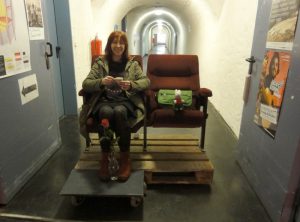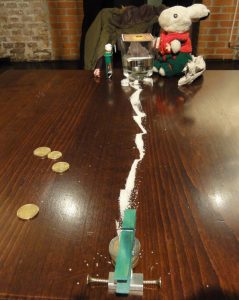 These days, success is often measured in numbers: how much money something made, how many people were involved, how many things were produced. Funders require these figures for their reporting, and the crowdsourcing trend reinforces the idea that big numbers are better. But where does that leave small-scale and experimental work? What of galleries that occupy tiny spaces, or one-on-one encounters between artists and their public? I have participated in many excellent small scale art projects and events over the years, with necessarily limited numbers. Most recently, I participated in “Matchpoint” at Signalraum in Munich, a weekend of one-on-one meetings between artists and “guests” who applied for a half-hour appointment with an artist. This kind of micro-event would not score highly on a more-is-better scale of success, but for the participants it was a richly rewarding and unique experience.
These days, success is often measured in numbers: how much money something made, how many people were involved, how many things were produced. Funders require these figures for their reporting, and the crowdsourcing trend reinforces the idea that big numbers are better. But where does that leave small-scale and experimental work? What of galleries that occupy tiny spaces, or one-on-one encounters between artists and their public? I have participated in many excellent small scale art projects and events over the years, with necessarily limited numbers. Most recently, I participated in “Matchpoint” at Signalraum in Munich, a weekend of one-on-one meetings between artists and “guests” who applied for a half-hour appointment with an artist. This kind of micro-event would not score highly on a more-is-better scale of success, but for the participants it was a richly rewarding and unique experience.
It wasn’t only the meeting that was a special encounter; the whole event was carefully hosted to ensure guests felt welcomed. When i descended the stairs (Signalraum is located in one of Munich’s many former underground bierkellers, cavernous brick cellars that in the days before refrigeration provided the vital service of keeping the beer cold in summer; these days they make great underground – literally – arts venues), I was personally welcomed by two guides wearing matching blue woolly pompom hats and invited to sit in a comfy old theatre seat atop a wheeled platform. I was handed a delicate little cup of herb tea, and a single red rose in a glass vase was placed between my feet; then I was slowly wheeled along the long corridor as I relaxed and drank the tea. In the foyer, tables and chairs were arranged cafe-style and I was asked to wait here for my appointment. In an adjacent space I could see one of the encounters taking place – a man and a woman, each balancing an apple on their head, moved in a slow silent dance together along a pattern of words made in white powder on the floor (later I was able to read it: “PRACTICE MAKES PERFECT”).
A few minutes later my personal guide, Consuela, appeared and introduced herself; a yellow safety helmet signified her guiding role. She offered me her arm and guided me further into the cellars, then knocked on a closed door. My artist was within – but he wasn’t ready yet; so Consuela and I waited and chatted. I learned that she was also one of the artists, but had already done her encounters for the day, which she said had been very interesting for her. Then, my artist was ready: the door opened into a large dark cellar with the light of a projection at the far end. Consuela waved as I entered the room and the heavy door closed behind me …
My artist turned out to be Dietmar Lupfer, who is a curator and one of the directors of Muffatwerk. He wished to present to me a specific project he had curated in 2006, “Crash Test Dummy“, as an example of his concept of curating events that bring artists together to create new work around a specific curatorial theme or concept (as opposed to a festival or exhibition that selects from existing works, for example). He said that he was not an artist himself, which I thought was curious as, to me, curation can definitely be an artistic activity; but I didn’t get to ask him about this, as half an hour was not long enough to explain such a fascinating large scale project. “Crash Test Dummy” invited artists and groups from Germany, Austria, Slovenia and Hungary to explore the idea of the new European “self” in a “bio-political crash test” – the situation of European citizens as the guinea-pigs of contemporary bio-political experiments on the public. Diverse works were produced, from a fake surveillance drone to “Bodyspin” (a spherical projection interface) and a video installation of a brick wall collapsing as cars crashed into it. I recognised many interconnecting threads between the project works and some of my own work.
It is quite a special thing to have a dedicated half-hour one-on-one presentation from an artist; we sat opposite each other across a small table, Dietmar projecting from his laptop to the wall behind him to show me images and video documentation. He gave me the catalogue, a well-produced A3 publication, and a questionnaire which had been part of the project. As the sole receiver of this information, in a pool of light from the projection at the end of a dark room, I felt a heightened sense of importance and concentration – as if secret information was being imparted to me.
Too soon our time was up, and Consuela came to offer me her guiding arm again. By luck, I was offered one more Matchpoint encounter (perhaps another guest had not turned up), which I naturally accepted, and this proved to be completely different to my meeting with Dietmar. English artist Ulysses Black invited me to join him in a game with no rules. We began by each selecting a card from a dozen or so laid out on the floor; mine, when i turned it over, said “complexity” (in English and Greek). Ulysses then emptied his pockets onto the table – coins, scrumpled papers, a packet of sugar, some staples, 2 screws, a peg – and asked if I had anything in my pockets to contribute to the game. I found my rabbit travelling companion, camera, and a tin of mints; we began to play.
 For 15 minutes we spoke very little, taking turns to place our playing pieces and becoming absorbed in the progress of the game. My word “complexity” was present in my mind, and I looked for opportunities to create complexities with our pocket detritus – balancing coins on a button, floating paper on the surface of a glass of water. Colour patterns and geometric shapes emerged, and the game gradually spread off the table to incorporate the chairs and the wider space of the room (a small cellar). At one point, Ulysses dipped his finger in the glass of water and let a drop fall onto sugar that I had sprinkled on the table. We both lent forward and intently observed the impact of the water on the sugar: it is hard to say whether the sugar absorbed the water, or the water infected the sugar. For a long time the water moved slowly but steadily further into the sugar, transforming it from white to translucent, changing its shape and texture. It was a very profound moment. When Ulysses’ phone alarm rang to signal 15 minutes, we stopped the game and started to chat about it. However once again time was running out – Consuela in her yellow hat was at the door, the next guest was waiting …
For 15 minutes we spoke very little, taking turns to place our playing pieces and becoming absorbed in the progress of the game. My word “complexity” was present in my mind, and I looked for opportunities to create complexities with our pocket detritus – balancing coins on a button, floating paper on the surface of a glass of water. Colour patterns and geometric shapes emerged, and the game gradually spread off the table to incorporate the chairs and the wider space of the room (a small cellar). At one point, Ulysses dipped his finger in the glass of water and let a drop fall onto sugar that I had sprinkled on the table. We both lent forward and intently observed the impact of the water on the sugar: it is hard to say whether the sugar absorbed the water, or the water infected the sugar. For a long time the water moved slowly but steadily further into the sugar, transforming it from white to translucent, changing its shape and texture. It was a very profound moment. When Ulysses’ phone alarm rang to signal 15 minutes, we stopped the game and started to chat about it. However once again time was running out – Consuela in her yellow hat was at the door, the next guest was waiting …
Two intimate encounters with artists I had not met before; one a very direct communication of information and the other an almost silent exercise in non-verbal collaboration. One meeting that introduced me to the work of many other European artists in the context of a large-scale public art project, the other an introspective meditation on the contents of our pockets. Both encounters had shone a torch briefly across an unfamiliar landscape, giving me a taste of these artists’ work and ideas, and leaving me with the curious feeling of having looked at something simultaneously from a great distance and very close up.
As Amanda Palmer reminds us, artists have traditionally been part of the community; it’s only recently that we’ve allowed this relationship to be distorted by the cult of celebrity, which Palmer describes as being “about a lot of people loving you from a distance”. Personal encounters re-establish that connection – whether it’s Pamer’s examples of eye-contact, couch-surfing, and Twitter connecting her to the help she needed in a strange city, or an event such as Matchpoint creating opportunities to meet each other. Personal contact anchors us within our communities – whether it be a geographical neighbourhood, an online community such as Netbehaviour or some other concept of community. Matchpoint states, “möchten wir auch die Besucher besser kennenlernen” – we would like to get to know the visitors better – and this is a welcome alternative to the “we want to have as many visitors as possible” model that we are all too often forced to accept.